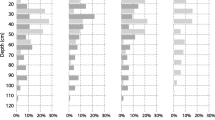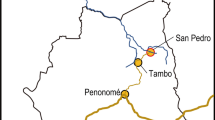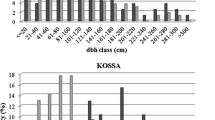Abstract
This research aimed to select conilon coffee tree clones (Coffea canephora Pierre ex A. Froehner) for agroforestry and/or intercropping systems. The experiment was carried out at Bananal do Norte Experimental Farm (20º45' S and 41º17' W), Espírito Santo, Brazil. The clones were evaluated in an agroforestry system with “urograndis” hybrid eucalyptus trees (Eucalyptus grandis W.Hill × E. urophylla S.T.Blake) plus prata-type banana herbs (Musa spp.) and an intercropping with ‘Folha Murcha’ sweet orange trees (Citrus sinensis (L.) Osbeck). An augmented block experiment design, with two plants per plot, four controls, in six blocks in the agroforestry system and four in the intercropping, was adopted. Thirteen morphophysiological characteristics were evaluated. Data analysis was performed using the restricted maximum likelihood method and best linear unbiased prediction and the significance of genetic effects by the likelihood ratio test. To select superior clones the Mulamba-Rank index was performed. Twenty clones were selected for the agroforestry and 20 for the intercropped system. The clones 16, 17, 35, 43, 48, 61, 64, 68 and T3 were the most promising for both systems. There is genetic variability to be explored among the clones, being possible the development of varieties, in the future, for agroforestry and intercropping systems.

Similar content being viewed by others
Data availability
Not applicable.
References
Abdo MTVN, Valeri SV, Martins ALM (2008) Sistemas agroflorestais e agricultura familiar: uma parceria interessante. Revista Tecnologia & Inovação Agropecuária 1:50–59
Alkimim ER, Caixeta ET, Sousa TV, Gois IB, Silva FL, Sakiyama NS, Zambolim L, Alves RS, Resende MDV (2021) Designing the best breeding strategy for Coffea canephora: Genetic evaluation of pure and hybrid individuals aiming to select for productivity and disease resistance traits. PLoS ONE 16:e0260997. https://doi.org/10.1371/journal.pone.0260997
Assis BP, Gross E, Pereira NE, Mielke MS, Júnior GAG (2019) Growth response of four Conilon coffee varieties (Coffea canephora Pierre ex A. Froehner) to different shading levels. J Agr Sci 11(7):29–41. https://doi.org/10.5539/jas.v11n7p29
Baca M, Läderach P, Haggar J, Schroth G, Ovalle O (2014) An integrated framework for assessing vulnerability to climate change and developing adaptation strategies for coffee growing families in mesoamerica. PLoS ONE 9:e88463. https://doi.org/10.1371/journal.pone.0088463
Bezerra SBO, Araújo LFB, Costa RSC, Souza VF, Rocha RB, Campanharo M, Espindula MC (2024) Cultivo de cafeeiro Coffea canephora em sistemas agroflorestais com bandarra, castanheira-do-brasil e teca. Semina Ciências Agrárias 45(1):49–70. https://doi.org/10.5433/1679-0359.2024v45n1p49
Carias CMOM, Gravina GA, Ferrão MAG et al (2016) Prediction of genetic gains by mixed models in conilon coffee progenies. Coffee Science 11:39–45. https://doi.org/10.25186/cs.v11i1.961
Cerda R, Deheuvels O, Calvache D, Niehaus L, Saenz Y, Kent J, Vilchez S, Villota A, Martinez C, Somarriba E (2014) Contribution of cocoa agroforestry systems to family income and domestic consumption: looking toward intensification. Agrofor Syst 88:957–981. https://doi.org/10.1007/s10457-014-9691-8
DaMatta FM, Avila RT, Cardoso AA, Martins SCV, Ramalho JC (2018) Physiological and Agronomic Performance of the Coffee Crop in the Context of Climate Change and Global Warming: A Review. J Agric Food Chem 66:5264–5274. https://doi.org/10.1021/acs.jafc.7b04537
Duarte EMG, Cardoso IM, Stijnen T, Mendonça MAFC, Coelho MS, Cantarutti RB, Kuyper TW, Villani EMA, Mendonça ES (2013) Decomposition and nutrient release in leaves of Atlantic Rainforest tree species used in agroforestry systems. Agrofor Syst 87:835–847. https://doi.org/10.1007/s10457-013-9600-6
Favarin JL, DouradoNeto D, García AG, Villa Nova NA, Favarin MGGV (2002) Equações para a estimativa do índice de área foliar do cafeeiro. Pesq Agrop Brasileira 37:769–773. https://doi.org/10.1590/S0100-204X2002000600005
Federer WT (1956) Augmented (hoonuiaku) designs. Hawaian Planters’ Record, Aica 55:191–208
Ferrão RG, Fonseca AFA, Ferrão MAG, Muner LH (2019) Conilon coffee, 3rd edn. Incaper, Vitória, pp 974
Galvanin EAS, Neves SMAS, Cruz CBM, Neves RJ, Jesus PHH, Kreitlow JP (2014) Avaliação dos índices de vegetação NDVI, SR e TVI na discriminação de fitofisionomias dos ambientes do Pantanal de Cáceres/MT. Ciência Florestal 24(3):707–715
Gomes LC, Cardoso IM, Mendonça ES et al (2016) Trees modify the dynamics of soil CO2 efflux in coffee agroforestry systems. Agric for Meteorol 224:30–39. https://doi.org/10.1016/j.agrformet.2016.05.001
Gomes LC, Bianchi FJJA, Cardoso IM, Fernandes RBA, FernandesFilho EI, Schulte RPO (2020) Agroforestry systems can mitigate the impacts of climate change on coffee production: A spatially explicit assessment in Brazil. Agr Ecosyst Environ 294:106858. https://doi.org/10.1016/j.agee.2020.106858
IPCC - Intergovernmental Panel on Climate Change (2019) Climate Change and Land: An IPCC Special Report on Climate Change, Desertification, Land Degradation, Sustainable Land Management, Food Security, and Greenhouse Gas Fluxes in Terrestrial Ecosystems. Accessed, 10 December 2022 https://www.ipcc.ch/report/srccl/
Jonsson M, Raphael IA, Ekbom B, Kyamanywa S, Karungi J (2015) Contrasting effects of shade level and altitude on two important coffee pests. J Pest Sci 88:281–287. https://doi.org/10.1007/s10340-014-0615-1
Koh I, Garrett R, Janetos A, Mueller ND (2020) Climate risks to Brazilian coffee production. Environ Res Lett 15:104015. https://doi.org/10.1088/1748-9326/aba471
Koutouleas A, Sarzynski T, Bordeaux M, SkovmandBosselmann A, Campa C, Etienne H, Turreira-Garcia N, Rigal C, Vaast P, CochichoRamalho J, Marraccini P (2022) Shaded-coffee: a nature-based strategy for coffee production under climate change? A Review Front Sustain Food Syst 6:877476. https://doi.org/10.3389/fsufs.2022.877476
Koutouleas A, Collinge DB, Raebild A (2022) Alternative plant protection strategies for tomorrow’s coffee. Plant Pathol 00:1–21. https://doi.org/10.1111/ppa.13676
Koutouleas A, Sarzynski T, Bertrand B, Bordeaux M, Bosselmann AS, Campa C, Etienne H, Turreira-García N, Léran S, Markussen B, Marraccini P (2022) Shade effects on yield across different Coffea arabica cultivars—how much is too much? A Meta-Analys Agron Sustain Dev 42(4):1–13. https://doi.org/10.1007/s13593-022-00788-2
Lin BL (2010) The role of agroforestry in reducing water loss through soil evaporation and crop transpiration in coffee agroecosystems. Agric for Meteorol 150:510–518. https://doi.org/10.1016/j.agrformet.2009.11.010
Meylan L, Gary C, Allinne C, Ortiz J, Jackson L, Rapidel B (2017) Evaluating the effect of shade trees on provision of ecosystem services in intensively managed coffee plantations. Agr Ecosyst Environ 245:32–42. https://doi.org/10.1016/j.agee.2017.05.005
Moguel P, Toledo VM (1999) Biodiversity conservation in traditional coffee systems of Mexico. Conserv Biol 13:11–21. https://doi.org/10.1046/j.1523-1739.1999.97153.x
Moreira SLS, Pires CV, Marcatti GE, Santos RHS, Imbuzeiro HMA, Fernandes RBA (2018) Intercropping of coffee with the palm tree, macauba, can mitigate climate change effects. Agric for Meteorol 256–257:379–390. https://doi.org/10.1016/j.agrformet.2018.03.026
Nair PKR (1997) Directions in tropical agroforestry research: past, present, and future. Agrofor Syst 38:223–245. https://doi.org/10.1023/A:1005943729654
Pendergrast M (2010) Uncommon grounds: the history of coffee and how it transformed our world. New York, pp 450
Pezzopane JRM, Marsetti MMS, Souza JM et al (2010) Condições microclimáticas em cultivo de café conilon a pleno sol e arborizado com nogueira macadâmia. Ciência Rural 40:1257–1263. https://doi.org/10.1590/S0103-84782010005000098
Pezzopane JRM, Marsetti MMS, Ferrari WR, Pezzopane JEM (2011) Alterações microclimáticas em cultivo de café conilon arborizado com coqueiro-anão-verde. Revista Ciência Agronômica 42:865–871. https://doi.org/10.1590/S1806-66902011000400007
Prado SG, Collazo JA, Irwin RE (2018) Resurgence of specialized shade coffee cultivation: Effects on pollination services and quality of coffee production. Agr Ecosyst Environ 265:567–575. https://doi.org/10.1016/j.agee.2018.07.002
Prezotti LC, Oliveira JA, Gomes JA, Dadalto GG (2007) Manual de recomendação de calagem e adubação para o estado do espírito santo: 5ª aproximação. Incaper, Vitória, pp 305
Ramalho AR, Rocha RB, Souza FF, Veneziano W, Teixeira AL (2016) Progresso genético da produtividade de café beneficiado com a seleção de clones de cafeeiro ‘Conilon.’ Ciência Agronômica 47:516–523. https://doi.org/10.5935/1806-6690.20160062
Reis AR, Favarin JL, Malavolta E, Júnior JL, Moraes MF (2009) Photosynthesis, Chlorophylls, and SPAD Readings in Coffee Leaves in Relation to Nitrogen Supply. Commun Soil Sci Plant Anal 40:1512–1528. https://doi.org/10.1080/00103620902820373
Resende MDV (2007a) Software SELEGEN-REML/BLUP: sistema estatístico e seleção genética computadorizada via modelos lineares mistos. Editora Embrapa Florestas: Colombo, Brazil, pp 359
Resende MDV (2007b) Matemática e estatística na análise de experimentos e no melhoramento genético. Colombo, Embrapa, pp 561
Resende MDV (2016) Software SELEGEN-REML/BLUP: a useful tool for plant breeding. Crop Breeding and Applied Biotechnology 16:330–339. https://doi.org/10.1590/1984-70332016v16n4a49
Resende MDV, Alves RS (2020) Linear, Generalized, Hierarchical, Bayesian and Random Regression Mixed Models in Genetics/Genomics in Plant Breeding. Functi Plant Breed J 2:1–31
Resende MDV, Duarte JB (2007) Precisão e controle de qualidade em experimentos de avaliação de cultivares. Pesquisa Agropecuária Tropical 37:182–194 (https://www.revistas.ufg.br/pat/article/view/1867/1773)
Rice RA (2011) Fruits from shade trees in coffee: how important are they? Agrofor Syst 83:41–49. https://doi.org/10.1007/s10457-011-9385-4
Rissini ALL, Kawakami J, Genú AM (2015) Índice de vegetação por diferença normalizada e produtividade de cultivares de trigo submetidas a doses de nitrogênio. Rev Bras Ciênc Solo 39(1):1703–1713. https://doi.org/10.1590/01000683rbcs20140686
Rodríguez-López NF, Cavatte PC, Silva PEM, Martins SCV, Morais LE, Medina EF, DaMatta FM (2013) Physiological and biochemical abilities of robusta coffee leaves for acclimation to cope with temporal changes in light availability. Physiol Plant 149:45–55. https://doi.org/10.1111/ppl.12010
Schmildt ER, Amaral JAT, Santos JS, Schmildt O (2016) Allometric model for estimating leaf area in clonal varieties of coffee (Coffea canephora). Revista Ciência Agronômica 46:740–748. https://doi.org/10.5935/1806-6690.20150061
Senra JFB, Silva JA, Ferrão MAG, Esposti MDD, Milheiros IS, Fassarella KM (2022a) Genetic variability of conilon coffee population from cultivar ‘ES8152’ based on morphoagronomic variables. Coffee Science 17:e171986. https://doi.org/10.25186/.v17i.1986
Senra, JFB, Silva JA, Araújo JBS, Silva UR, Zacarias AJ, Conceição AO, Milheiros IS, Verdin Filho AC, Silva FG (2022b) Seleção de genótipos de cafeeiro conilon para sistemas agroflorestais ou consorciados. Conjecturas 22. https://conjecturas.org/index.php/edicoes/article/view/1404
Siles P, Harmand J, Vaast P (2010) Effects of Inga densiflora on the microclimate of coffee (Coffea arabica L.) and overall biomass under optimal growing conditions in Costa Rica. Agrofor Syst 78:269–286. https://doi.org/10.1007/s10457-009-9241-yn
Silva JA, Senra JFB, Esposti MDD, Milheiros IS, Silva UR, Conceição AO, Zacarias AJ (2022) Characterization of the vegetative vigor, and SPAD readings and vegetation index in a Coffea canephora population. Research, Society and Development 11, 15:254111537314. https://doi.org/10.33448/rsd-v11i15.37314
Somarriba E, Suárez-Islas A, Calero-Borge W, Villota A, Castillo C, Mendoza SV, Deheuvels O, Cerda RH (2014) Cocoa–timber agroforestry systems: Theobroma cacao–Cordia alliodora in Central America. Agrofor Syst 88:1001–1019. https://doi.org/10.1007/s10457-014-9692-7
Souza HN, Goede RGM, Brussaard L, Cardoso IM, Duarte EMG, Fernandes RBLC, Pulleman MM (2012) Protective shade, tree diversity and soil properties in coffee agroforestry systems in the Atlantic Rainforest biome. Agr Ecosyst Environ 146:179–196. https://doi.org/10.1016/j.agee.2011.11.007
Souza HN, Graaff J, Pulleman MM (2012) Strategies and economics of farming systems with coffee in the Atlantic Rainforest Biome. Agrofor Syst 84:227–242. https://doi.org/10.1007/s10457-011-9452-x
Torres Netto A, Oliveira ECJG, Bressan-Smith RE (2005) Photosynthetic pigments, nitrogen, chlorophyll a fluorescence and SPAD-502 readings in coffee leaves. Sci Hortic 104(2):199–209. https://doi.org/10.1016/j.scienta.2004.08.013
Vaast P, Raghuramulu Y (2012) Coffee quality in coffee agroforestry systems of Kodagu, Western Ghats of India. Indian Coffee 76:10–11
Valentini LSP, Camargo MBP, Rolim LS et al (2010) Temperatura do ar em sistemas de produção de café arábica em monocultivo e arborizados com seringueira e coqueiro-anão na região de Mococa, SP. Bragantia 69:1005–1010. https://doi.org/10.1590/S0006-87052010000400028
Venancio LP, Teixeira AJF, Cavatte PC, Vargas CT, Reis EF, Dias JR et al (2019) Vegetative growth and yield of robusta coffee genotypes cultivated under different shading levels. Bioscience Journal 35:1490–1503. https://doi.org/10.14393/BJ-v35n5a2019-45039
Acknowledgements
The authors would like to thank the Fundação de Amparo à Pesquisa e Inovação do Espírito Santo (FAPES), Consórcio Pesquisa Café, Conselho Nacional de DesenvolvimentoCientifico e Tecnológico (CNPq) and INCAPER, for financial, structural and, or research grant support.
Funding
This research was funded by Fundação de Amparo à Pesquisa e Inovação do Espírito Santo (FAPES) and Consórcio Pesquisa Café.
Author information
Authors and Affiliations
Contributions
Conceptualization, J.F.B.S. and M.D.D.E.; methodology, J.F.B.S., M.D.D.E. and J.A.S.; software, J.F.B.S. and J.A.S.; validation, J.F.B.S., M.D.D.E. and J.A.S.; formal analysis, J.F.B.S. and J.A.S.; investigation, J.F.B.S., J.A.S., A.J.Z., A.O.C., I.S.M., U.R.S.; resources, J.F.B.S. and M.D.D.E.; data curation, J.F.B.S. and J.A.S.; writing—original draft preparation, J.F.B.S. and J.A.S.; writing—review and editing, J.F.B.S., M.D.D.E., J.A.S. and M.L.D.; visualization, J.F.B.S., M.D.D.E., J.A.S. and M.L.D.; supervision, J.F.B.S.; project administration, J.F.B.S.; funding acquisition, J.F.B.S. and M.D.D.E.
Corresponding author
Ethics declarations
Competing interests
The authors declare no competing interests.
Additional information
Publisher's Note
Springer Nature remains neutral with regard to jurisdictional claims in published maps and institutional affiliations.
Rights and permissions
Springer Nature or its licensor (e.g. a society or other partner) holds exclusive rights to this article under a publishing agreement with the author(s) or other rightsholder(s); author self-archiving of the accepted manuscript version of this article is solely governed by the terms of such publishing agreement and applicable law.
About this article
Cite this article
de Brites Senra, J.F., da Silva, J.A., Esposti, M.D.D. et al. Promising conilon coffee trees clones for agroforestry and intercropping systems. Agroforest Syst (2024). https://doi.org/10.1007/s10457-024-00988-7
Received:
Accepted:
Published:
DOI: https://doi.org/10.1007/s10457-024-00988-7




